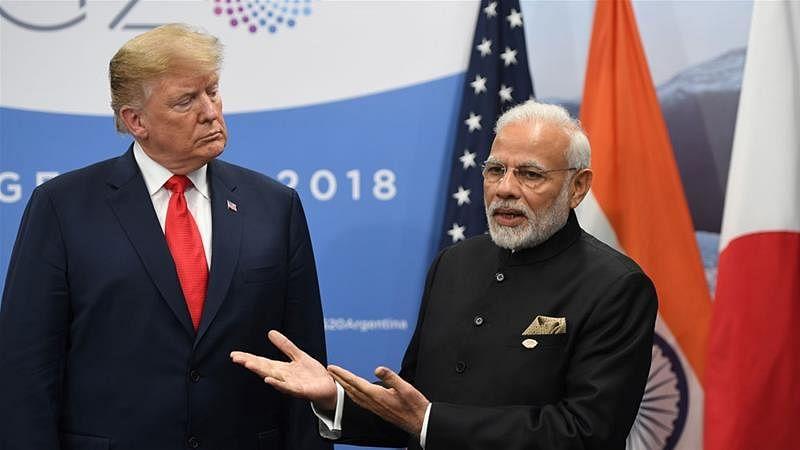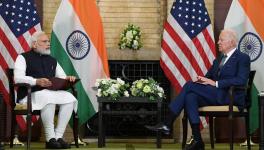Trump ‘Really Likes’ Modi but India, Not so Much

United States President Donald Trump will be in India for two days—24 and 25 February. If the anticipation is that the presidential visit will singularly deepen relations between the two countries, such expectations may take a hit.
Trump has been both talking up and talking down his visit in the past few days. Unfortunately, the bits he has been talking up are in the spheres of the symbolic and the personal, while the bits he’s been talking down are in the realm of the substantial. It’s something like what the lexicographer Samuel Johnson told an aspiring writer about a manuscript. Paraphrased: Your manuscript is both good and original. But the parts that are good aren’t original and the parts that are original aren’t good.
Trump, of course, is always original or, at least, he makes every effort to be. In the personal and symbolic department, he’s original but not really good for India. He has been reiterating for the past week that he really likes Prime Minister Narendra Modi, but has little to say about India that is encouraging.
In the symbolism department, he seems to be inordinately excited by the fact that seven million people will line the road to greet him as he makes the journey from the airport to the new Motera sports stadium, billed as one of the largest in the world and capable of hosting 1,10,000 Modi that seven million people will brave the elements to welcome him. If that sounds unlikely, given that the prime minister is never short on the realistic side of things, some suggest that Trump has confused lakh with million. If that is, indeed, the case it will represent a downscaling to one-tenth of expectations. There is no surety that even the revised one-million-strong attendance will materialise.
That being as it might, the point is that the personal chemistry between Trump and Modi will not likely benefit the country overmuch, for reasons we will shortly broach. Nor will the symbolism of however many people welcoming the president of the United States. In fact, there could be a downside to straining too much to make the ‘Namaste Trump’ event a success. At the ‘Howdy Modi’ in Houston, Texas, on 22 September 2019, it may be recalled, Modi had virtually pitched for Trump’s re-election later this year. This was hardly wise, given the bipartisan support India gets in the United States, not to mention the impropriety of getting involved in the domestic politics of another country, a kind of activity the Indian establishment routinely decries.
As for the substantive part of Trump’s agenda, the news is bad. In the run-up to his visit, the United States president has been criticising India in a manner that hardly raises expectations of a trip that will be mutually beneficial.
Sample these comments: “I’m going to India next week and we’re talking trade. They’ve [India has] been hitting us hard for many, many years but I really like Prime Minister Modi... They’ve been hitting us hard. They give us tariffs, one of the highest in the world is India.” Allied to this is the following statement: ‘But it’s [the visit is] going to result in more products proudly stamped with the beautiful phrase “Made in the USA”.’
It is not too difficult to decode what Trump’s agenda is. It is to arm-twist India into lowering tariffs to allow more United States-made products to get into the Indian market, without any parallel commitment to easing access to the United States market for Indian goods. Bilateral trade between the two countries is contracting. This is in consonance with Trump’s policy of ‘America first’, pursued by blunt instruments like threatening to withdraw from the World Trade Organization, which would make trade-related negotiation and adjudication that much more difficult to pursue.
These accusations and threats have been levelled despite the fact that India has acceded to following police directions that favour the United States, strategically and economically. Let us begin with the Iran case. On the back of sanctions imposed by the Trump administration on Iran, India had initially said it would continue to import fuel from that country. But since the middle of last year, it ceased to import oil from Iran, when the “conditional waiver” given by the United States for Iranian imports expired. This is hardly in India’s interests given that India used to import a huge amount of fuel from Iran, and stopping them restricts India’s options.
Then there is the question of defence spending. India’s defence purchases from the United States have spiralled in the past few years, while its purchases from Russia have fallen significantly. When Trump talks about being hit hard by India, he should perhaps remember this fact. Since Modi became prime minister, India’s defence purchases have risen to $17 billion. It is unlikely that anyone will remind Trump of that while he is waiting for a million people to welcome him.
The United States under Trump is trying to impose a unilateralism on the world, not just India, which is driven by an extreme version of national interest fuelled by the president’s megalomania and penchant for demagogy. There is no doubt that strategically speaking India needs to remain constructively engaged with the United States. But this engagement cannot be at the cost of discounting its own economic interests and becoming a satellite power.
It should neither be on the basis of trying to play out fantasies of becoming a superpower, which India must hope to get by piggybacking on the United States. That is not likely to happen because the ‘only superpower’ of the world does not want competitors and India is hardly in the position yet of claiming a seat at the high table, despite becoming the fifth-largest economy in the world.
The author is a freelance journalist and researcher. The views are personal.
Get the latest reports & analysis with people's perspective on Protests, movements & deep analytical videos, discussions of the current affairs in your Telegram app. Subscribe to NewsClick's Telegram channel & get Real-Time updates on stories, as they get published on our website.
















